ATI Radeon 7500

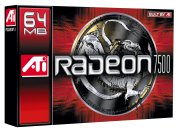
Introduction
We've just recently posted our review of the R8500, ATi's flagship graphics card. As the reviewer in charge I enjoyed the change from the NVIDIA cards that I've had in my system just recently. I get to continue my NVIDIA hiatus again with an ATi card, this time with the Radeon 7500. The 7500 is the next card down from the 8500 in ATi's lineup and something of an enigma. It took me a little while to figure out exactly what made the 7500 core. When I first saw the spec on the core with it's name of RV200 I assumed it was a full R200 core, as seen in the 8500 with some features disabled on the silicon.
However the name is misleading. The RV200 is infact the Rage6C core as seen on the original Radeon, only this time it has seen a die shrink to 0.15 micron from 0.18 micron. This allows ATi to increase the clock speed of the new core dramatically from the old 183Mhz on the shipping retail DDR Radeon's to 290Mhz on this example I have in my machine at the time of writing. It shares the 2 render pipes and the 3 texture units per pipeline of the Rage6C. Also with an increase in memory clock from 183Mhz (retail DDR Radeon) to 230Mhz on this card we see a 1.5Gb/sec increase in memory bandwidth over the old card to 7.4Gb/sec.
So that's the silicon of the card out of the way, lets move on to the rest of the features that make up the card and core.
Features
Being an old Radeon at heart, the card shares the same feature set, with some extras of course:
- Charisma Engine - T&L engine
- Pixel Tapestry - 32bit rendering engine
- HydraVision - Dual independent displays
- DVI support for digital flat panels
- Support for 230Mhz DDR memory
- HyperZ - Memory bandwidth optimisations
Lets take a look at some of those in turn. First off we have the Charisma Engine. This is ATi's 1st generation transform and lighting engine, their GPU. The also make big news of the fact it supports some character animation features in hardware including keyframe interpolation.
Pixel Tapestry is their 32bit colour renderer. The Charisma Engine is a data source for the Pixel Tapestry unit. It supports multitexturing and rendering of 3 textures per pixel in each of it's 2 rendering pipelines.
HydraVision is a technology I first saw on a Radeon VE graphics card that a friend uses in a high end workstation. It allows for independent control over 2 output sources which can be number of devices including regular CRT monitors, TV and DVI enabled flat panels. Supplied is a DVI-to-VGA adaptor for running a VGA panel from the DVI port present on the card.
HyperZ is a technology like the Charisma Engine and PT units that have seen an upgrade on the R200 core but in this form on the RV200 gives us an increase in effective memory bandwidth that ATi claims to be 20%. It uses Z buffer compression, testing and exclusion of pixels before they hit the framebuffer while they reside in the Z buffer and a method of very quickly clearing the Z buffer. Combined (the features can be turned on or off individually in the driver) they give a speed up on the card.
Card Installation
While I had some problems getting the R8500 to work properly, installing the 7500 after the 8500 was easy. I removed the 8500 drivers using the control panel in Windows XP, turned off the computer, removed the 8500 and installed the 7500, booted the machine and ran the driver installation program. A reboot or 2 later and everything is working perfectly. Very smooth and how it should have been for me when I installed the 8500.
I would usually comment on the software bundle on a retail card such as this. However sometimes you don't get the luxury of a full review box from a manufacturer or retailer. In this case all I received was the card and cables for both 8500 and 7500, all packed tight in the 7500 retail box and no software was provided.
Performance
As usual before discussing performance, a quick rundown of the test system. It's basically the same system as used on the 8500.
Test System:
- Asus P4T-E i850 Intel Pentium 4 Motherboard
- Intel 2.0GHz Processor
- 2 x 256Mb RDRAM modules
- Adaptec 39160 PCI SCSI Dual Channel U160 controller
- 2 x 73Gb Seagate Cheetah U160 10,000rpm SCSI disks
- Plextor 12/10/32S SCSI CDRW
- Creative 12x IDE DVD
The software installed on the test system is the same. Windows XP Professional (no pre SP1 patches), the ATi Recommended Driver - 6.13.3276 for Windows XP and the benchmarking software and finally this copy of Homesite 5 for writing the review. The next section of the review is copied verbatim from the 8500 review since it's also relevant here.
We tested card performance using the 3 most common methods of determining graphics card performance in reviewing circles, Quake 3 (v1.30), Unreal Tournament (G.O.T.Y Edition, v436) and MadOnion's 3DMark 2001 Professional.
For benchmarking Quake3 we used Q3Bench with the following settings.
Main tab
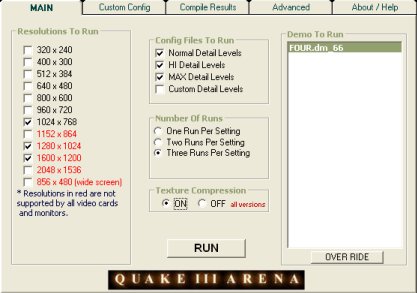
Custom config tab
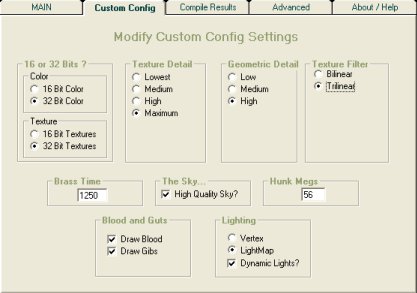
So for benching Q3 we used resolutions above 1024x768 in 32-bit colour and 32-bit textures with all quality rendering options on to really stress the card.
For benchmarking Unreal Tournament we used the same resolutions and the Thunder demo from Reverend. Direct3D render options in the preferences dialog were set to defaults.
For 3DMark we did a default bench with everything as standard. No driver tweaks were used. V-Sync was off for all 3 tests.
The 3 tests give us a broad look at the card performance using 2 DirectX benchmarks and an OpenGL benchmark. 3DMark also tests DirectX 8 features like pixel and vertex shaders. While no two applications are the same and it's not wise to generalise performance using such a small cross section of applications the 3 applications do comprise the 'standard' applications used in most reviews so we use them.
Performance Results
Card clocks were the standard 290/230Mhz out the box clocks of the shipping card. First up, Quake3. Remember, all high quality rendering options are on including 32-bit colour, 32-bit textures and trilinear texture filtering to really stress the card.
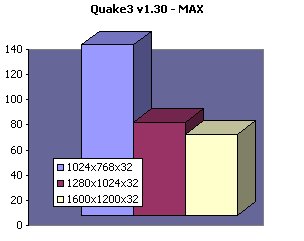
As you can see, the 1024x768 result is close to double that of the 1280x1204 result. In that case, the performance is entirely CPU bound. If we were to slowly increase CPU speed at 1024x768 and re-run the test, we'd eventually hit a plateau of performance where the number never increased. At that point the CPU is feeding the card data faster than it can process and only increasing the card clocks will increase performance. Until that point of CPU speed, the card is doing the waiting. So even with a 2Ghz Pentium 4 processor and the extremely quick i850/RAMBUS combination driving the card, the 7500 is still quick enough to be waiting.
As we increase resolution to 1280x1024 and 1600x1200 we see successive drop offs in performance. The drop from the 1024x768 score to the 1280x1024 score is quite large indicating to use that in that resolution, performance is card bound. Increasing card clocks will be needed to increase performance at the higher resolutions and texture and colour depths. Remember that the Radeon is as happy at 32-bit colour rendering as it is at 16-bit rendering and it's pointless running the card at 16-bit if you have the CPU horsepower to back it up. Fillrate is really being tested at these higher resolutions as the card is required to shift more and more data around.
Next up, the Unreal Tournament numbers.

Doing a little bit of analysis on the figures show that the two successive increases in resolution give an 18% percent performance drop each time. UT is more dependant on CPU for it's performance than the graphics card. The performance drop may not be that great however it is a consequence of the extra graphics horsepower needed to display the rendered frames.
Lastly in our benchmark suite we've got 3DMark 2001 Professional.
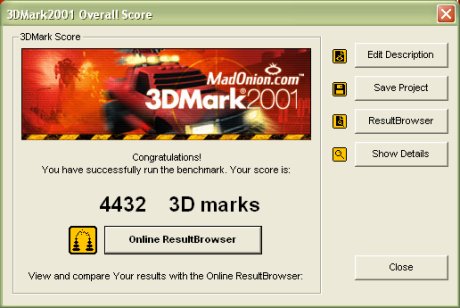
Hampered by it's inability to run the Nature test due it not supporting the DirectX 8 pixel and vertex shader specification, the 7500 posts a fairly low score compared to a GF3, Ti500 or it's bigger brother the 8500. Again, keep in mind the test platform and operating system. Windows 98 is a faster operating system for 3DMark scores.
Overclocking
It seems as tho ATi were grateful enough to send me a nice pair of cards overclocking wise. The 8500 I have just tested completed 3DMark at 305/305 with no rendering errors or anomalies and went up to around 312/313 and completed 3DMark with rendering errors (framebuffer and vertex anomalies). This 7500 was no exception. The maximum 3DMark score without rendering errors was completed at an impressive 342/290 and gave the following score.
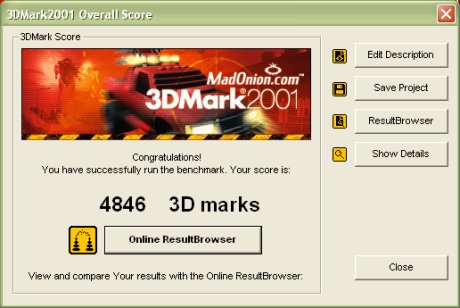
Rendering errors soon crept in and the memory clock couldn't be raised further than 290 without errors or complete crashes. Quite impressive for 4ns memory without any active or passive cooling of any kind whatsoever. I run no case fans in the board half of my YY Cube so there was little to no moving air around the card. I was able to increase the core clock slightly higher however before rendering errors kicked in or I experienced crashes. Here was my maximum clock rate.

The actual speed I set in Powerstrip was 345Mhz core however it is downclocked when setting the values. From what I can gather by analysing the project titles in the MadOnion Online Result Browser for 3DMark 2001 for the 7500, anything above 340/280 is impressive. Remember the card cooling was completely stock. No extra fans or special cooling was used. Just out of the box performance. Maybe ATi sent us a nice one on purpose but there ARE other cards around that do those kind of clocks. I'm very impressed at the overclocking range available in this test card. +55/+60 is excellent for a stock cooled card. It's obvious the 0.15 die shrink that the Rage6C was given is helping the card to achieve very nice clocks.
Conclusion and Notes
Before I make a conclusion I'd like to point out that like the 8500, DVD playback and using TV-out was perfect. I'm watching the final parts of the Devils Advocate as I type this using the Radeon as the playback device using WinDVD. Pacino is just into his final god decrying speeches and it's very smooth. The Radeon is well known for it's iDCT hardware implementation and excellent DVD playback and it's certainly working well for me.
Game compatibility was flawless, running everything I gave it. Max Payne was a tad stuttery at higher resolutions but what do you expect from a card in this class with no vertex and pixel shader support that Max craves. Top marks for application compatibility.
On a card in this class we must also take a look at price. Current cheapest on PriceWatch UK is a lowly £120 from Dabs.com. That's an excellent price for the feature set and performance you are given. HydraVision is excellent, DVI is great and the 2D image quality, as always from ATi is superb. It's main competitor in the UK at that price is the Gainward GeForce2 Ti/450 TV Golden Sample 64MB DDR from OcUK. Those cards offer higher performance but less features than the 7500 so it's up to the user to weigh up the pro's and cons at this price point. Do you want excellent DVD playback and HydraVision dual display? Need DVI for your new flat panel? If so then the ATi Radeon 7500 is a good choice.
For the price/performance, credit is due. The overclocking potential seems amazing too. I like this card a lot. It's no GF3/Ti500/8500 by any stretch and a well clocked GF2 will also see it off in the performance stakes, but there's more to this card than meets the eye and if you can see that, I think you'll enjoy it if it fits your needs.













